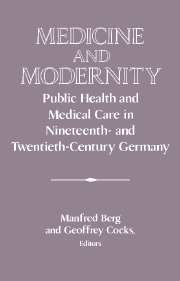Book contents
- Frontmatter
- Introduction
- 1 To Benefit the Poor and Advance Medical Science: Hospitals and Hospital Care in Germany, 1820-1870
- 2 From Traditional Individualism to Collective Professionalism: State, Patient, Compulsory Health Insurance, and the Panel Doctor Question in Germany, 1883—1931
- 3 In Search of German Social Darwinism: The History and Historiography of a Concept
- 4 Modern German Doctors: A Failure of Professionalization?
- 5 The Mentally Ill Patient Caught between the State's Demands and the Professional Interests of Psychiatrists
- 6 Rationalizing the Therapeutic Arsenal: German Neuropsychiatry in World War I
- 7 Sterilization and “Medical” Massacres in National Socialist Germany: Ethics, Politics, and the Law
- 8 The Old as New: The Nuremberg Doctors' Trial and Medicine in Modern Germany
- 9 The Debate that Will Not End: The Politics of Abortion in Germany from Weimar to National Socialism and the Postwar Period
- 10 The Sewering Scandal of 1993 and the German Medical Establishment
- Index
10 - The Sewering Scandal of 1993 and the German Medical Establishment
Published online by Cambridge University Press: 05 January 2013
- Frontmatter
- Introduction
- 1 To Benefit the Poor and Advance Medical Science: Hospitals and Hospital Care in Germany, 1820-1870
- 2 From Traditional Individualism to Collective Professionalism: State, Patient, Compulsory Health Insurance, and the Panel Doctor Question in Germany, 1883—1931
- 3 In Search of German Social Darwinism: The History and Historiography of a Concept
- 4 Modern German Doctors: A Failure of Professionalization?
- 5 The Mentally Ill Patient Caught between the State's Demands and the Professional Interests of Psychiatrists
- 6 Rationalizing the Therapeutic Arsenal: German Neuropsychiatry in World War I
- 7 Sterilization and “Medical” Massacres in National Socialist Germany: Ethics, Politics, and the Law
- 8 The Old as New: The Nuremberg Doctors' Trial and Medicine in Modern Germany
- 9 The Debate that Will Not End: The Politics of Abortion in Germany from Weimar to National Socialism and the Postwar Period
- 10 The Sewering Scandal of 1993 and the German Medical Establishment
- Index
Summary
[For Hans Mommsen on his sixty-fifth birthday] In 1933, fifty-nine years before he was elected president of the World Medical Association for a one-year term, a young German medical student joined Heinrich Himmler's black-shirted SS, and one year later the Nazi Party. His name was Hans Joachim Sewering, and he had come from his home town of Bochum to enroll at the University of Munich. Sewering joined those Nazi organizations of his own accord. Whereas male university students, for the sake of university admittance until the Röhm Putsch in June 1934, had to demonstrate a working affiliation with the SA, the SS, and the Nazi Party did not call for compulsory membership. Sewering was therefore not typical. In the period from 1933 to 1945, only 6 percent of male students of medicine joined the SS, and only 29 percent the party, and like Sewering, they did so for careerist, less than for ideological reasons. Sewering certainly exhibited opportunism when he took up residence at the Munich headquarters of the university-affiliated SA storm troopers (SA-Hochschulamt) on Theresienstrasse.
After graduating with a doctor of medicine degree in April of 1941, Sewering entered the Wehrmacht (armed forces), but he was found to be unfit for service and discharged in the summer of 1942. Thereupon he began to work at Schonbrunn sanatorium near the town of Dachau, north of Munich, which specialized in the care of tuberculosis patients. When he arrived there, the institution had been nearly emptied after the evacuation, to a “euthanasia” killing center, of most of its patients.
- Type
- Chapter
- Information
- Medicine and ModernityPublic Health and Medical Care in Nineteenth- and Twentieth-Century Germany, pp. 213 - 234Publisher: Cambridge University PressPrint publication year: 1997
- 2
- Cited by



